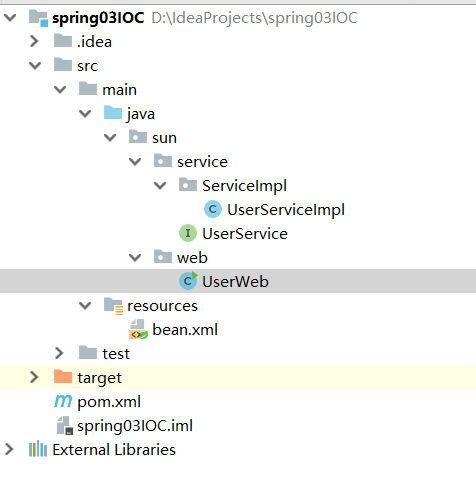Spring基于XML的IOC环境搭建及入门
一、使用Maven构建Java项目
* 项目目录结构

1、 在sun.service包下创建UserDao接口和接口实现类:
UserDao接口:

package sun.service; /** * @Classname UserService * @Description TODO * @Date 2020/9/15 14:51 * @Created by Administrator */ public interface UserService { void saveUser(); }
UserDao接口实现类:

package sun.service.ServiceImpl; import org.springframework.context.ApplicationContext; import org.springframework.context.support.ClassPathXmlApplicationContext; import sun.service.UserService; /** * @Classname UserServiceImpl * @Description TODO * @Date 2020/9/15 14:52 * @Created by Administrator */ public class UserServiceImpl implements UserService { public void saveUser() { System.out.println("service saveUser方法执行了..."); } }
2、在sun.web包下创建UserWeb类模拟Servlet:
UserWeb类:

package sun.web; import org.springframework.context.ApplicationContext; import org.springframework.context.support.ClassPathXmlApplicationContext; import sun.service.ServiceImpl.UserServiceImpl; import sun.service.UserService; /** * @Classname UserWeb * @Description TODO * @Date 2020/9/15 14:54 * @Created by Administrator */ public class UserWeb { public static void main(String[] args) { // 1 获取核心容器对象 ApplicationContext ac=new ClassPathXmlApplicationContext("bean.xml"); // 2 根据id获取bean对象 UserService userService = ac.getBean("userService", UserService.class); userService.saveUser(); } }
在main方法中通过 ApplicationContext ac=new ClassPathXmlApplicationContext("bean.xml") 读取bean.xml配置文件获取Spring核心容器对象。
再通过 UserService userService = ac.getBean("userService", UserService.class) 根据传入的id字符串获取该id对应的class类的对象。
3、在resource目录下创建bean.xml配置文件:

<?xml version="1.0" encoding="UTF-8"?> <beans xmlns="http://www.springframework.org/schema/beans" xmlns:xsi="http://www.w3.org/2001/XMLSchema-instance" xsi:schemaLocation="http://www.springframework.org/schema/beans http://www.springframework.org/schema/beans/spring-beans.xsd"> <bean id="userService" class="sun.service.ServiceImpl.UserServiceImpl"></bean> </beans>
4、在pom.xml配置文件中添加jar包坐标:

<?xml version="1.0" encoding="UTF-8"?> <project xmlns="http://maven.apache.org/POM/4.0.0" xmlns:xsi="http://www.w3.org/2001/XMLSchema-instance" xsi:schemaLocation="http://maven.apache.org/POM/4.0.0 http://maven.apache.org/xsd/maven-4.0.0.xsd"> <modelVersion>4.0.0</modelVersion> <groupId>sun</groupId> <artifactId>spring03IOC</artifactId> <version>1.0-SNAPSHOT</version> <packaging>jar</packaging> <dependencies> <dependency> <groupId>org.springframework</groupId> <artifactId>spring-context</artifactId> <version>5.0.2.RELEASE</version> </dependency> </dependencies> </project>
二、ApplicationContext相关
1、ApplicationContext三个常用实现类:
1、ClassPathXmlApplicationContext:
它可以加载类路径下的配置文件,要求配置文件必须在类路径下。不在的话,加载不了。(更常用)
2、FileSystemXmlApplicationContext:
它可以加载磁盘任意路径下的配置文件(必须有访问权限)
3、AnnotationConfigApplicationContext:
它是用于读取注解创建容器。
2、ApplicationContext和BeanFactory接口区别:
1、ApplicationContext(单例对象适用 ) 它在构建核心容器时,创建对象采取的策略是采用立即加载的方式。也就是说,只要一读取完配置文件马上就创建配置文件中配置的对象。
ApplicationContext ac=new ClassPathXmlApplicationContext("bean.xml"); UserService userService = ac.getBean("userService", UserService.class); userService.saveUser(); 2、BeanFactory(多例对象适用 ) 它在构建核心容器时,创建对象采取的策略是采用延迟加载的方式。也就是说,什么时候根据id获取对象了,什么时候才真正的创建对象。 Resource resource = new ClassPathResource("bean.xml"); BeanFactory factory = new XmlBeanFactory(resource); UserService as = (UserService)factory.getBean("userService"); System.out.println(as);
三、Spring的bean相关
1、Spring中bean细节之创建Bean对象的三种方式
1)使用默认构造方法创建
在Spring的配置文件中使用bean标签,配以id和class属性之后,且没有其他属性和标签时,采用的就是默认构造函数创建bean对象,此时如果类中没有默认构造函数,则对象无法创建。
bean.xml
<?xml version="1.0" encoding="UTF-8"?> <beans xmlns="http://www.springframework.org/schema/beans" xmlns:xsi="http://www.w3.org/2001/XMLSchema-instance" xsi:schemaLocation="http://www.springframework.org/schema/beans http://www.springframework.org/schema/beans/spring-beans.xsd"> <bean id="userService" class="sun.service.ServiceImpl.UserServiceImpl"></bean>
</beans>
2)使用工厂类的普通方法创建对象(使用某个类中的方法创建对象,并存入Spring容器)
bean.xml
<?xml version="1.0" encoding="UTF-8"?> <beans xmlns="http://www.springframework.org/schema/beans" xmlns:xsi="http://www.w3.org/2001/XMLSchema-instance" xsi:schemaLocation="http://www.springframework.org/schema/beans http://www.springframework.org/schema/beans/spring-beans.xsd"> <bean id="instance" class="sun.factory.InstanceFactory"></bean> <bean id="userServiceMethod" factory-bean="instance" factory-method="getObj"></bean> </beans>
3)使用工厂类中的静态方法创建对象(使用某个类中的静态方法创建对象,并存入Spring容器)
bean.xml
<?xml version="1.0" encoding="UTF-8"?> <beans xmlns="http://www.springframework.org/schema/beans" xmlns:xsi="http://www.w3.org/2001/XMLSchema-instance" xsi:schemaLocation="http://www.springframework.org/schema/beans http://www.springframework.org/schema/beans/spring-beans.xsd"> <bean id="userServiceStatic" class="sun.factory.StaticFactory" factory-method="getObj"></bean> </beans>
2、Spring中bean的作用范围
bean标签的scope属性:
作用:用于指定bean的作用范围
取值: 常用的就是单例的和多例的
singleton:单例的(默认值)
prototype:多例的
request:作用于web应用的请求范围
session:作用于web应用的会话范围
global-session:作用于集群环境的会话范围(全局会话范围),当不是集群环境时,它就是session
bean.xml
<?xml version="1.0" encoding="UTF-8"?> <beans xmlns="http://www.springframework.org/schema/beans" xmlns:xsi="http://www.w3.org/2001/XMLSchema-instance" xsi:schemaLocation="http://www.springframework.org/schema/beans http://www.springframework.org/schema/beans/spring-beans.xsd"> <bean id="userService" class="sun.service.ServiceImpl.UserServiceImpl" scope="prototype"></bean> </beans>
3、Bean对象的生命周期
单例对象
出生:当容器创建时对象出生
活着:只要容器还在,对象一直活着
死亡:容器销毁,对象消亡
总结:单例对象的生命周期和容器相同
多例对象
出生:当我们使用对象时spring框架为我们创建
活着:对象只要是在使用过程中就一直活着。
死亡:当对象长时间不用,且没有别的对象引用时,由Java的垃圾回收器回收
UserServiceImpl类:

package sun.service.ServiceImpl; import org.springframework.context.ApplicationContext; import org.springframework.context.support.ClassPathXmlApplicationContext; import sun.service.UserService; /** * @Classname UserServiceImpl * @Description TODO * @Date 2020/9/15 14:52 * @Created by Administrator */ public class UserServiceImpl implements UserService { public void init(){ System.out.println("init..."); } public void saveUser() { System.out.println("service saveUser方法执行了..."); } public void destory(){ System.out.println("destory..."); } }
UserWeb类:

package sun.web; import org.springframework.context.ApplicationContext; import org.springframework.context.support.ClassPathXmlApplicationContext; import sun.service.ServiceImpl.UserServiceImpl; import sun.service.UserService; /** * @Classname UserWeb * @Description TODO * @Date 2020/9/15 14:54 * @Created by Administrator */ public class UserWeb { public static void main(String[] args) { // 1 获取核心容器对象 ClassPathXmlApplicationContext ac=new ClassPathXmlApplicationContext("bean.xml"); // 2 根据id获取bean对象 UserService userService = ac.getBean("userService", UserService.class); userService.saveUser(); ac.close(); } }
1)当bean.xml中配置的是单例模式时:
<?xml version="1.0" encoding="UTF-8"?> <beans xmlns="http://www.springframework.org/schema/beans" xmlns:xsi="http://www.w3.org/2001/XMLSchema-instance" xsi:schemaLocation="http://www.springframework.org/schema/beans http://www.springframework.org/schema/beans/spring-beans.xsd"> <bean id="userService" class="sun.service.ServiceImpl.UserServiceImpl" init-method="init" destroy-method="destory" scope="singleton"></bean> </beans>
此时运行UserWeb中的main方法:

2)当bean.xml中配置的是多例模式时:
<?xml version="1.0" encoding="UTF-8"?> <beans xmlns="http://www.springframework.org/schema/beans" xmlns:xsi="http://www.w3.org/2001/XMLSchema-instance" xsi:schemaLocation="http://www.springframework.org/schema/beans http://www.springframework.org/schema/beans/spring-beans.xsd"> <bean id="userService" class="sun.service.ServiceImpl.UserServiceImpl" init-method="init" destroy-method="destory" scope="prototype"></bean> </beans>
此时运行UserWeb中的main方法:

四、Spring中的依赖注入
依赖注入:
Dependency Injection
IOC的作用:
降低程序间的耦合(依赖关系)
依赖关系的管理:
以后都交给spring来维护
在当前类需要用到其他类的对象,由spring为我们提供,我们只需要在配置文件中说明
依赖关系的维护:
就称之为依赖注入。
依赖注入:
能注入的数据:有三类
基本类型和String
其他bean类型(在配置文件中或者注解配置过的bean)
复杂类型/集合类型
注入的方式:有三种
第一种:使用构造函数提供
第二种:使用set方法提供
第三种:使用注解提供(明天的内容)
1、使用构造函数注入
构造函数注入:
使用的标签:constructor-arg
标签出现的位置:bean标签的内部
标签中的属性
type:用于指定要注入的数据的数据类型,该数据类型也是构造函数中某个或某些参数的类型
index:用于指定要注入的数据给构造函数中指定索引位置的参数赋值。索引的位置是从0开始
name:用于指定给构造函数中指定名称的参数赋值 常用的
=============以上三个用于指定给构造函数中哪个参数赋值===============================
value:用于提供基本类型和String类型的数据
ref:用于指定其他的bean类型数据。它指的就是在spring的Ioc核心容器中出现过的bean对象
bean实体类:

package sun.service.ServiceImpl; import org.springframework.context.ApplicationContext; import org.springframework.context.support.ClassPathXmlApplicationContext; import sun.service.UserService; import java.util.Date; /** * @Classname UserServiceImpl * @Description TODO * @Date 2020/9/15 14:52 * @Created by Administrator */ public class UserServiceImpl implements UserService { private String name; private Integer age; private Date birthday; public UserServiceImpl(String name, Integer age, Date birthday) { this.name = name; this.age = age; this.birthday = birthday; } public void saveUser() { System.out.println("service saveUser方法执行了..."); } @Override public String toString() { return "UserServiceImpl{" + "name='" + name + '\'' + ", age=" + age + ", birthday=" + birthday + '}'; } }
bean.xml中的配置:
<?xml version="1.0" encoding="UTF-8"?> <beans xmlns="http://www.springframework.org/schema/beans" xmlns:xsi="http://www.w3.org/2001/XMLSchema-instance" xsi:schemaLocation="http://www.springframework.org/schema/beans http://www.springframework.org/schema/beans/spring-beans.xsd"> <bean id="userService" class="sun.service.ServiceImpl.UserServiceImpl"> <constructor-arg name="name" value="kelvin"></constructor-arg> <constructor-arg name="age" value="23"></constructor-arg> <constructor-arg name="birthday" ref="time"></constructor-arg> </bean> <bean id="time" class="java.util.Date"></bean> </beans>
优势:
在获取bean对象时,注入数据是必须的操作,否则对象无法创建成功。
弊端:
改变了bean对象的实例化方式,使我们在创建对象时,如果用不到这些数据,也必须提供。
2、set方法注入(更常用的方式)
涉及的标签:property
出现的位置:bean标签的内部
标签的属性
name:用于指定注入时所调用的set方法名称
value:用于提供基本类型和String类型的数据
ref:用于指定其他的bean类型数据。它指的就是在spring的Ioc核心容器中出现过的bean对象
bean实体类:

package sun.service.ServiceImpl; import sun.service.UserService; import java.util.Date; /** * @Classname UserServiceImpl * @Description TODO * @Date 2020/9/15 14:52 * @Created by Administrator */ public class UserServiceImpl2 implements UserService { private String name; private Integer age; private Date birthday; public void setName(String name) { this.name = name; } public void setAge(Integer age) { this.age = age; } public void setBirthday(Date birthday) { this.birthday = birthday; } public void saveUser() { System.out.println("service saveUser方法执行了..."); } @Override public String toString() { return "UserServiceImpl{" + "name='" + name + '\'' + ", age=" + age + ", birthday=" + birthday + '}'; } }
bean.xml中的配置:
<?xml version="1.0" encoding="UTF-8"?> <beans xmlns="http://www.springframework.org/schema/beans" xmlns:xsi="http://www.w3.org/2001/XMLSchema-instance" xsi:schemaLocation="http://www.springframework.org/schema/beans http://www.springframework.org/schema/beans/spring-beans.xsd"> <bean id="time" class="java.util.Date"></bean> <bean id="userService2" class="sun.service.ServiceImpl.UserServiceImpl2"> <property name="name" value="jack"></property> <property name="age" value="23"></property> <property name="birthday" ref="time"></property> </bean>
</beans>
优势:
创建对象时没有明确的限制,可以直接使用默认构造函数
弊端:
如果有某个成员必须有值,则获取对象是有可能set方法没有执行。
* 注入集合数据(可采用构造注入或set注入完成)
复杂类型的注入/集合类型的注入
用于给List结构集合注入的标签:
list array set
用于个Map结构集合注入的标签:
map props
结构相同,标签可以互换
bean实体类:

package sun.service.ServiceImpl; import sun.service.UserService; import java.util.*; /** * @Classname UserServiceImpl * @Description TODO * @Date 2020/9/15 14:52 * @Created by Administrator */ public class UserServiceImpl3 implements UserService { private String[] strings; private List<String> list; private Set<String> set; private Map<String,Integer> map; private Properties prop; public void setStrings(String[] strings) { this.strings = strings; } public void setList(List<String> list) { this.list = list; } public void setSet(Set<String> set) { this.set = set; } public void setMap(Map<String, Integer> map) { this.map = map; } public void setProp(Properties prop) { this.prop = prop; } public String[] getStrings() { return strings; } public List<String> getList() { return list; } public Set<String> getSet() { return set; } public Map<String, Integer> getMap() { return map; } public Properties getProp() { return prop; } public void saveUser() { System.out.println("service saveUser方法执行了..."); System.out.println(Arrays.toString(strings)); System.out.println(this.list); System.out.println(this.set); System.out.println(this.map); System.out.println(this.prop); } }
bean.xml
<?xml version="1.0" encoding="UTF-8"?> <beans xmlns="http://www.springframework.org/schema/beans" xmlns:xsi="http://www.w3.org/2001/XMLSchema-instance" xsi:schemaLocation="http://www.springframework.org/schema/beans http://www.springframework.org/schema/beans/spring-beans.xsd"> <bean id="userService3" class="sun.service.ServiceImpl.UserServiceImpl3"> <property name="strings"> <array> <value>kelvin</value> <value>jack</value> <value>tony</value> </array> </property> <property name="set"> <set> <value>kelvin</value> <value>jack</value> <value>tony</value> </set> </property> <property name="list"> <list> <value>kelvin</value> <value>jack</value> <value>tony</value> </list> </property> <property name="map"> <map> <entry key="kelvin" value="23"></entry> <entry key="jack" value="21"></entry> <entry key="tony"> <value>46</value> </entry> </map> </property> <property name="prop"> <props> <prop key="kelvin">23</prop> <prop key="jack">45</prop> <prop key="tony">32</prop> </props> </property> </bean> </beans>
❤️ 如果你喜欢这篇文章,请点赞支持! 👍 同时欢迎关注我的博客,获取更多精彩内容!
本文来自博客园,作者:佛祖让我来巡山,转载请注明原文链接:https://www.cnblogs.com/sun-10387834/p/13679682.html



 浙公网安备 33010602011771号
浙公网安备 33010602011771号